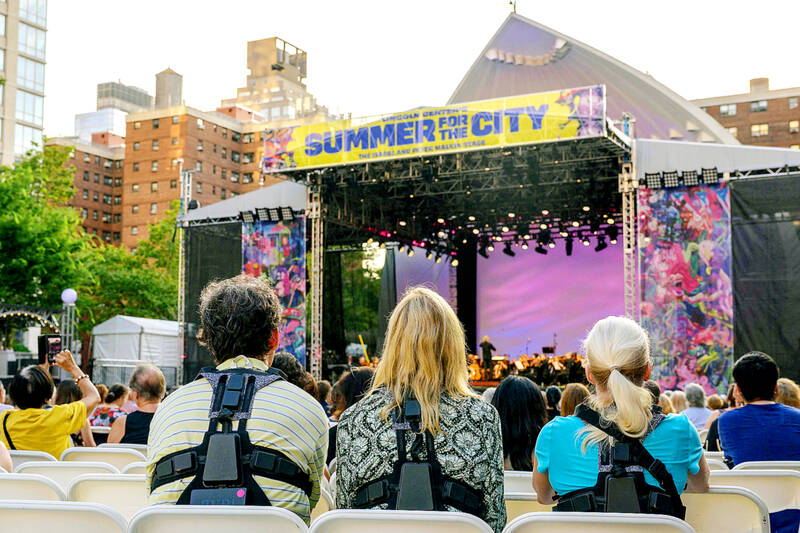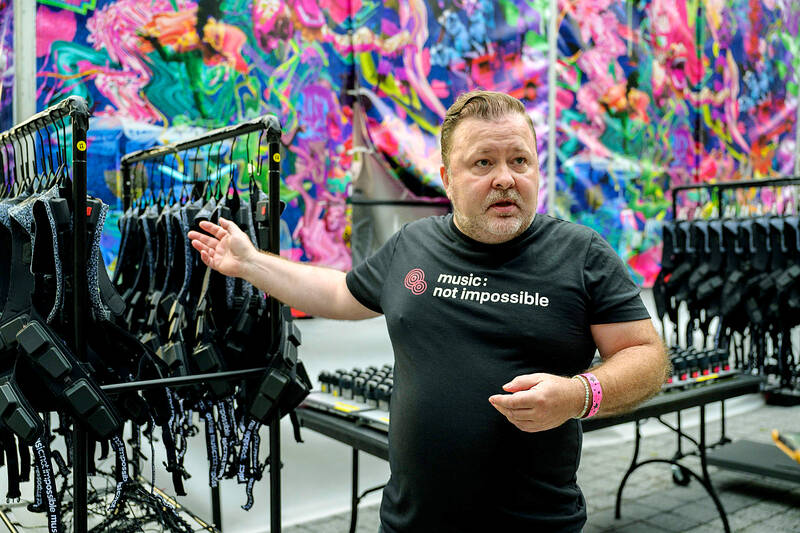The violins reverberate in the ribcage, while cello and bass are felt a little further down, with horns in the shoulders and, more often than not, soloists in the wrists.
That’s one way audio expert Patrick Hanlon programs haptic suits, designed to enable concertgoers who are deaf or hard of hearing to experience orchestral music, as initiatives to improve inclusivity at live music performances break new ground.
At a recent classical concert at Manhattan’s Lincoln Center, audience members had the chance to try on the wireless vests, featuring 24 points of vibration translating the music onstage.

Photo: AFP
“It engages the body,” Hanlon said prior to the show, giving attendees a “3D-surround experience through vibrations.”
Hanlon is a co-founder of Music: Not Impossible, an arm of Not Impossible Labs, which employs tech to try to alleviate social barriers, including those around disability.
Previous methods that deaf and hard of hearing individuals would use to enjoy live music included literally putting their hands on speakers, or holding a balloon to feel vibrations in their fingertips.

Photo: AFP
The aim of the vests — along with bands at the wrists or ankles — is to allow for a full-body experience, creating sensations that render the feelings music can evoke. “Nobody expects it to be so engaging,” Hanlon said of the vests. “And when you see it in people’s eyes, it’s magical.”
Jay Zimmerman, a composer whose ability to hear was damaged due to the Sept. 11, 2001 terrorist attacks, says the vests are an example of new technology offering more flexibility and dynamism than had been available previously.
“My hope is down the road, is that we will be able to let deaf kids have experiences with real vibrations and real materials up close, so they start building this library of auditory memory — even if it’s not auditory through their ears, it’s just different sensations,” he said. “I think if we can put it all together, there’s real opportunities for us.”
The Lincoln Center began working with Music: Not Impossible in 2021, both for orchestra shows and for their popular outdoor silent disco series.
Its most recent collaboration had 75 vests on offer during its outdoor concert as part of Korean Arts Week, which featured renditions of Korean folk music as well as Mozart’s Concerto No. 2. Liza Fiol-Matta was among the attendees, and though she is not hard of hearing, she was excited to test the tech.
“Music is my major love, and the idea that there can be an experiential sense of the music for anybody” is exciting, she said. “But also for the deaf and hearing impaired — that’s perfect.”
“I love the idea of immersion, the whole immersive experience ... music happens at so many different levels.”
Flavia Naslausky, the business head for Music: Not Impossible, described how during early testing, Mandy Harvey — a singer who lost her hearing after an illness — was able to match the sound of the music after feeling the vibration that translated it.
“That’s when we knew that we were right on, because if somebody that wasn’t hearing, from that vibration could match that note — we were on the right direction,” Naslausky said.
Music: Not Impossible’s vests are not genre-limited. Hanlon explained audio leads like him can adjust the vibration points to fit a show’s vibe, from rock to disco.
The vests have been used at Greta Van Fleet and Lady Gaga concerts. Zimmerman is excited about the technology’s potential — but there’s still a far way to go.
“Ultimately, the big goal for me is that I will be able to feel a soft violin and it will be so gorgeous to my body and my mind that I would cry,” he said. “And I could feel that exact same note come through a trombone blast and it will be so hilarious I’m going to laugh.”
“That is the big dream.”

Wooden houses wedged between concrete, crumbling brick facades with roofs gaping to the sky, and tiled art deco buildings down narrow alleyways: Taichung Central District’s (中區) aging architecture reveals both the allure and reality of the old downtown. From Indigenous settlement to capital under Qing Dynasty rule through to Japanese colonization, Taichung’s Central District holds a long and layered history. The bygone beauty of its streets once earned it the nickname “Little Kyoto.” Since the late eighties, however, the shifting of economic and government centers westward signaled a gradual decline in the area’s evolving fortunes. With the regeneration of the once

Even by the standards of Ukraine’s International Legion, which comprises volunteers from over 55 countries, Han has an unusual backstory. Born in Taichung, he grew up in Costa Rica — then one of Taiwan’s diplomatic allies — where a relative worked for the embassy. After attending an American international high school in San Jose, Costa Rica’s capital, Han — who prefers to use only his given name for OPSEC (operations security) reasons — moved to the US in his teens. He attended Penn State University before returning to Taiwan to work in the semiconductor industry in Kaohsiung, where he

On May 2, Chinese Nationalist Party (KMT) Chairman Eric Chu (朱立倫), at a meeting in support of Taipei city councilors at party headquarters, compared President William Lai (賴清德) to Hitler. Chu claimed that unlike any other democracy worldwide in history, no other leader was rooting out opposing parties like Lai and the Democratic Progressive Party (DPP). That his statements are wildly inaccurate was not the point. It was a rallying cry, not a history lesson. This was intentional to provoke the international diplomatic community into a response, which was promptly provided. Both the German and Israeli offices issued statements on Facebook

Perched on Thailand’s border with Myanmar, Arunothai is a dusty crossroads town, a nowheresville that could be the setting of some Southeast Asian spaghetti Western. Its main street is the final, dead-end section of the two-lane highway from Chiang Mai, Thailand’s second largest city 120kms south, and the heart of the kingdom’s mountainous north. At the town boundary, a Chinese-style arch capped with dragons also bears Thai script declaring fealty to Bangkok’s royal family: “Long live the King!” Further on, Chinese lanterns line the main street, and on the hillsides, courtyard homes sit among warrens of narrow, winding alleyways and